When you’re starting out with drumming, understanding and practicing the basic rudiments is essential. These foundational exercises, like the single stroke roll and double stroke roll, build your coordination and control. Mastering these will set you up for more intricate patterns and fills down the line. But have you ever wondered why the single paradiddle and double paradiddle are so emphasized, or how the flam and flamacue fit into the bigger picture? There’s more to these rudiments than just repetitive drills, and exploring their purpose can really change your approach to practice.
TL-DR
- Single Stroke Roll: Fundamental for speed, control, and endurance; focus on consistent stick heights and even strength.
- Double Stroke Roll: Vital for finger control, speed, and endurance; practice leading with both hands.
- Single Paradiddle: Enhances stick control and coordination; use R L R R or L R L L patterns.
- Double Paradiddle: Combines two single paradiddles; improves hand dexterity and fills execution.
- Flam: Adds dynamic touch and complexity; enhances control and precision in various music genres.
Single Stroke Roll
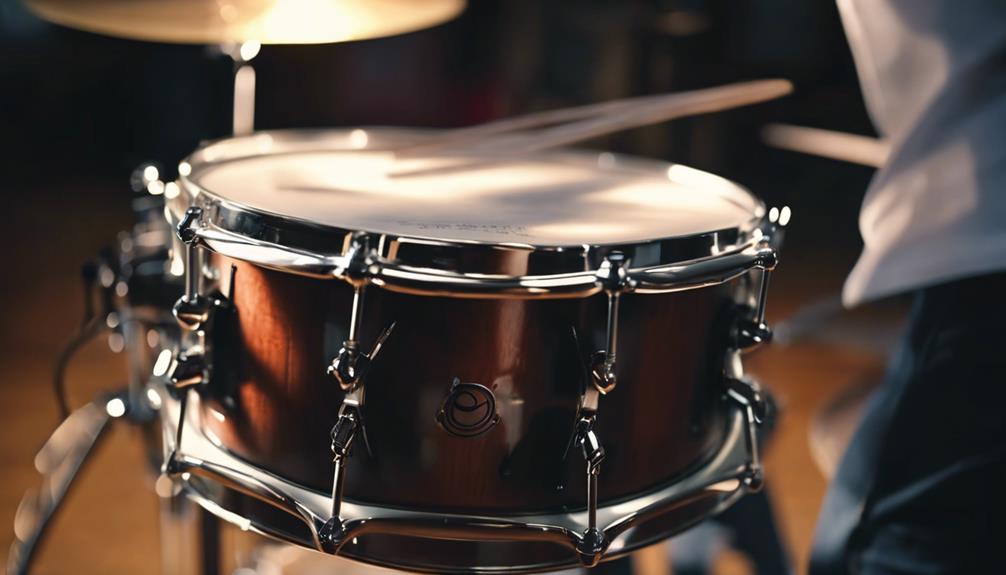
The single stroke roll, where you alternate strokes with each hand, is a fundamental rudiment every drummer must master. It’s considered the gold standard for developing speed, control, and endurance on the drum kit. By focusing on this rudiment, you’ll build a strong foundation in drumming technique that will serve you well in any musical context.
When you practice the single stroke roll, start slowly. Pay close attention to keeping your stick heights consistent and making sure each stroke has even strength. This attention to detail is important because it guarantees that your hands develop the muscle memory needed for more complex patterns. Use a metronome to keep your timing accurate and gradually increase the speed as you become more comfortable.
Mastering the single stroke roll is essential for playing basic beats, fills, and solos. It’s the backbone of many drum patterns and provides the versatility needed to adapt to various musical styles.
You’ll find that investing time in perfecting this rudiment will make all other aspects of drumming easier and more fluid. So, grab your sticks, set aside dedicated practice time, and watch your drumming skills soar as you conquer the single stroke roll.
Double Stroke Roll
Mastering the double stroke roll, which involves playing two strokes with each hand, is vital for advancing your drumming technique. This fundamental rudiment is essential for developing finger control, speed, and endurance. By perfecting the double stroke roll, you’ll notice significant improvements in your overall drumming skills.
To get started, focus on leading with both hands to guarantee even stroke strength and coordination. It’s important to practice slowly at first, gradually increasing your speed as you become more comfortable. Consistency and patience are key here.
As you practice, you’ll find that the double stroke roll can be applied across various drums and cymbals, adding versatility to your drumming patterns.
The double stroke roll isn’t just about speed; it also enhances your ability to play faster and more complex rhythms effectively. Many drummers find that mastering this rudiment opens up new possibilities in their playing, making their performances more dynamic and engaging.
Single Paradiddle
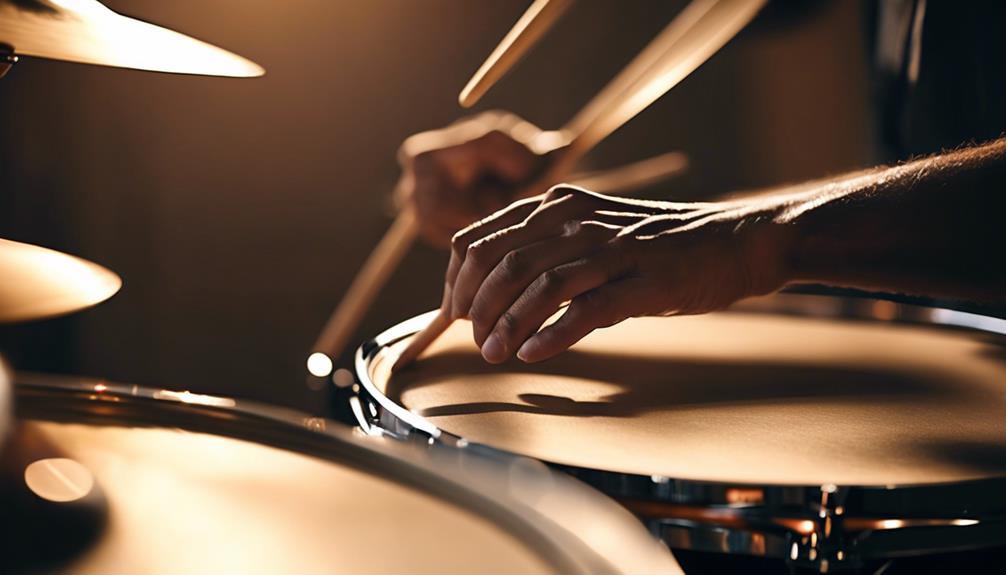
When working on the single paradiddle, focus on the basic stick movements:
R L R R or L R L L.
Start slowly to guarantee each stroke is clear, then gradually increase your speed.
Incorporating practice techniques like using a metronome and varying accents will help you master this rudiment.
Basic Stick Movements
Starting with the single paradiddle, you’ll play a sequence of four notes: RLRR or LRLL. This drum rudiment is crucial for developing stick control and enhancing your drumming technique.
By alternating single and double strokes, you’ll improve your hand coordination and independence. Begin practicing the single paradiddle slowly to guarantee even spacing and a consistent sound. This foundational rudiment will greatly enhance your overall drumming skills.
When working on the single paradiddle, pay close attention to your stick movements. Each stroke should be intentional and controlled, focusing on achieving a balanced sound between your hands. As you become more comfortable, gradually increase your speed while maintaining precision. This rudiment’s alternating pattern creates a versatile tool for your drumming arsenal.
Incorporate the single paradiddle into various drum beats, fills, and solos to add creativity and complexity to your playing. It’s not just about speed; it’s also about the quality of each stroke. Mastering this rudiment will lay a strong foundation for more complex drum rudiments in the future.
Practice Techniques
To effectively practice the single paradiddle, start by using a metronome to guarantee consistent timing and gradually increase your speed. The single paradiddle is a foundational rudiment with the pattern ‘RLRR’ or ‘LRLL’.
Begin slowly to focus on hand coordination and stick control. This helps build muscle memory, ensuring each stroke is even and precise.
Using a metronome, set it to a slow tempo that allows you to play the pattern cleanly. As you get comfortable, incrementally increase the tempo. Consistent timing is essential to developing solid drumming skills, and this practice technique will help you achieve it.
To add dynamics to your practice, experiment with incorporating accents within the single paradiddle pattern. Accenting different notes can transform a straightforward rudiment into a more musical and expressive element. For example, accent the first stroke of each paradiddle to emphasize the downbeat.
Don’t just stick to the practice pad; apply the single paradiddle to your drum set. Use it in drum beats, fills, and solos to enhance your versatility and creativity. Integrating this rudiment into various musical contexts will make your drumming more fluid and dynamic.
Double Paradiddle
At its core, the Double Paradiddle combines two single paradiddles to create a more complex and versatile drumming pattern. This rudiment, counted as ‘RLRRLL’ or ‘LRLLRR’, is essential for developing your hand coordination and dexterity.
By mastering the Double Paradiddle, you’ll find that your ability to execute more intricate fills, grooves, and solos will greatly improve.
Start by practicing the Double Paradiddle slowly. Focus on ensuring each stroke is even and that you’re alternating hands smoothly. This rudiment’s structure means that after every six strokes, your lead hand switches, which can be a bit tricky at first.
However, with consistent practice, you’ll notice your hand coordination getting better.
Use a metronome to keep a steady tempo and gradually increase the speed as you become more comfortable. Don’t rush; the goal is to maintain control and precision.
Incorporate the Double Paradiddle into your daily practice routine, and soon, it will become second nature.
Flam
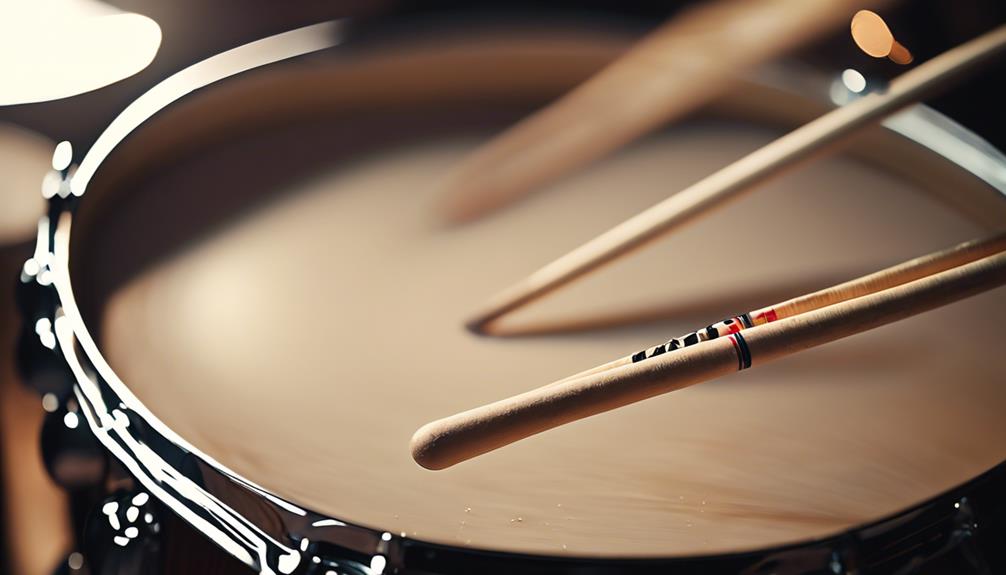
For a dynamic touch in your drumming, mastering the flam is essential. A flam involves playing a light grace note followed by a louder primary stroke. This small yet impactful rudiment adds depth and complexity to your drumming patterns, making your beats stand out.
By incorporating flams into your practice routine, you’ll develop better control and precision.
Practicing flams isn’t just about hitting two notes; it’s about achieving the right timing and balance between the grace note and the primary stroke. This drum rudiment is commonly used in various music genres to create unique and impactful drum fills.
Whether you’re playing rock, jazz, or classical, a well-executed flam can elevate your performance.
Here are some key benefits of mastering flams:
- Enhances your drumming dynamics and accents.
- Improves your control and precision.
- Adds depth to your drum fills.
- Boosts your expression and creativity.
- Broadens your versatility across different music genres.
Don’t rush the process. Take your time to practice flams slowly, ensuring each grace note and primary stroke is clear and distinct. With consistent practice, you’ll find that flams become a powerful tool in your drumming arsenal.
Drag
Now that you know what a drag is, let’s explore its roll technique, stick control exercises, and practice tempo variations.
Start by perfecting the drag roll to guarantee smooth shifts between the grace note and primary stroke.
Then, practice with different tempos to gain control and add precision to your drumming.
Drag Roll Technique
Mastering the drag roll technique can add a dynamic layer to your drumming patterns and fills. A drag in drumming is basically a grace note played just before the primary stroke, creating a distinct and expressive sound.
To effectively execute a drag roll, you need to focus on coordination and control. Practicing drags with both hands will help you develop the necessary skills and improve your overall drumming technique.
Here are some key points to keep in mind when working on your drag roll technique:
- Practice Slowly: Start at a slower tempo to make sure each grace note and primary stroke is clear and precise.
- Use a Metronome: This will help you maintain consistent timing and improve coordination between your hands.
- Focus on Evenness: Both the grace notes and primary strokes should be evenly spaced for a smooth roll.
- Alternate Hands: Practice dragging with both hands to build ambidexterity and control.
- Incorporate into Fills: Experiment with adding drag rolls into your drumming patterns and fills to enhance your musical expression.
Stick Control Exercise
To enhance your stick control and master the drag, start by practicing the drag exercise with a focus on precision and timing. Drags involve playing a grace note followed by a primary note, creating a subtle embellishment in your drumming. These are indicated by a symbol resembling a backward slash (\) in drum notation.
Begin by practicing drags slowly to guarantee consistent spacing and control between the grace note and the primary note. This stick control exercise is vital for developing hand coordination and enhancing your overall drumming expression. By paying close attention to the precise execution of each grace note, you’ll build the foundation necessary for clean and dynamic drags.
Drags aren’t just technical exercises; they’re practical tools used in drum fills and embellishments, adding flair and dynamics to your drumming patterns. As you get comfortable, you’ll notice an improvement in your stick control, allowing you to execute these with greater ease and fluidity.
Practice Tempo Variations
Practicing drags at various tempos helps you develop better control and coordination in your drumming. The drag rudiment, which includes a single grace note followed by a primary stroke, is essential for dynamic expression. By varying your practice tempo, you’ll enhance your ability to execute drags smoothly and consistently.
Here’s how to effectively practice tempo variations for drag rudiments:
- Start Slow: Begin at a slow tempo to focus on precision and technique.
- Gradual Increase: Gradually increase the tempo, ensuring you maintain clean execution.
- Metronome Use: Practice with a metronome to keep a steady rhythm and tempo.
- Random Tempo Changes: Challenge yourself by randomly changing tempos to improve adaptability.
- Versatile Application: Apply drags to different musical styles and contexts to become a more versatile drummer.
When practicing drag rudiments, concentrate on keeping your stick heights consistent. This consistency helps in achieving a smooth shift between the grace note and the primary stroke.
Additionally, incorporate drags into your drum fills to add subtle nuances and accents, making your playing more expressive.
Five-Stroke Roll

The five-stroke roll, consisting of five alternating strokes, is a fundamental rudiment every drummer should master. It’s typically played as Right, Left, Right, Right, Left (R L R R L) or Left, Right, Left, Left, Right (L R L L R).
Practicing this rudiment helps you develop better control, coordination, and stroke consistency. By working on the five-stroke roll, you’ll notice improvements in your hand speed and overall drumming precision.
Start slow to make sure each stroke is clean and even. Gradually increase your speed as your control and coordination improve. This rudiment is great for creating quick bursts of sound, adding excitement and dynamic variation to your drumming. You’ll find the five-stroke roll to be highly versatile, fitting seamlessly into various drumming styles and patterns.
Incorporate it into your practice routine by playing it within different contexts, such as drum fills or grooves. Experiment with different tempos and dynamics to fully grasp its potential.
Mastering the five-stroke roll will greatly enhance your drumming skills, making you a more versatile and expressive drummer. So, grab your sticks and start rolling!
Seven-Stroke Roll
Mastering the seven-stroke roll, an essential rudiment, will greatly enhance your drumming speed and control. This rudiment consists of seven alternating single strokes. In a 4/4 time signature, you count it as ‘1-and-a-2-and-a.’
It’s fantastic for developing not only your speed and control but also adding flair to your drum fills.
To get started, you should practice the seven-stroke roll slowly. Focus on maintaining consistent stroke heights to guarantee each note is clear and articulate. As you become more comfortable, gradually increase your speed while still prioritizing control.
Here are some tips to help you master the seven-stroke roll:
- Start slow: Begin at a slower tempo to guarantee accuracy and evenness.
- Use a metronome: This helps to keep your timing precise.
- Focus on dynamics: Pay attention to the volume of each stroke, aiming for a consistent sound.
- Alternate hands: Practice starting with both your left and right hand to develop ambidexterity.
- Incorporate into fills: Experiment with using the seven-stroke roll in your drum fills to add complexity.
Flam Tap
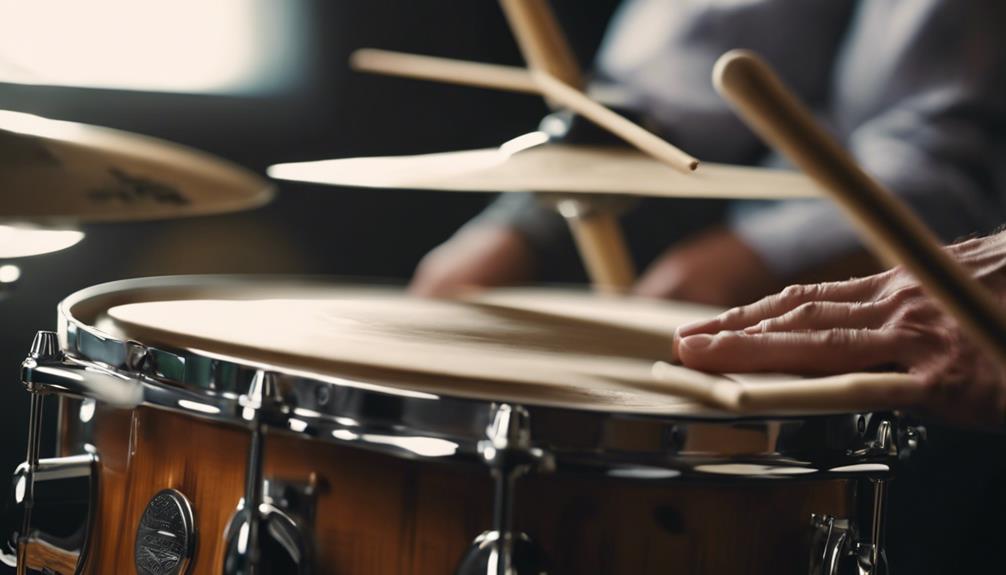
Get ready to elevate your drumming skills with the flam tap, a rudiment that merges a flam with a tap stroke for dynamic and expressive playing. The flam tap consists of a soft grace note followed by a louder primary stroke, creating a distinctive sound that enhances your drumming’s overall texture.
To master the flam tap, focus on control and dynamics. Start by playing a flam, where a light grace note precedes a stronger primary stroke. Immediately follow it with a single tap stroke using the opposite hand. Practice alternating leading hands to guarantee both sides of your body develop evenly. This approach will greatly enhance your coordination and precision.
Incorporating flam taps into your drum fills and solos adds flair and expression, making your performance stand out. The variation in volume between the grace note and the primary stroke brings a dynamic quality to your playing, allowing for more emotional and textured drumming.
Regular practice of flam taps not only hones your control but also improves your ability to execute complex patterns smoothly. As you become more comfortable with this rudiment, you’ll notice a notable improvement in your overall drumming dynamics and coordination.
Flamacue
You’ll find that the flamacue, consisting of a flam followed by a single stroke, brings a dynamic and accented flair to your drumming patterns. This drum rudiment combines a soft grace note (flam) and a louder primary stroke, creating a contrast that enhances the overall dynamics of your playing.
Mastering the flamacue can greatly improve your hand control and coordination, making it an essential rudiment for any drummer.
To practice the flamacue, start slowly and focus on the evenness of your strokes. Gradually increase your speed while maintaining control. The key is to make sure that the grace note is soft and the primary stroke is pronounced, adding a layer of complexity to your drumming.
Here are some benefits of incorporating flamacue into your practice:
- Improves hand control and coordination: Practicing flamacue helps you gain better control over your hands, which is important for advanced drumming.
- Adds dynamics to your playing: The contrast between the flam and the primary stroke creates dynamic variation.
- Enhances drum fills: Use flamacue in drum fills to add flair and complexity.
- Versatile application: Flamacue can be integrated into various musical genres.
- Builds rhythmic precision: Regular practice refines your timing and precision.
Triple Stroke Roll
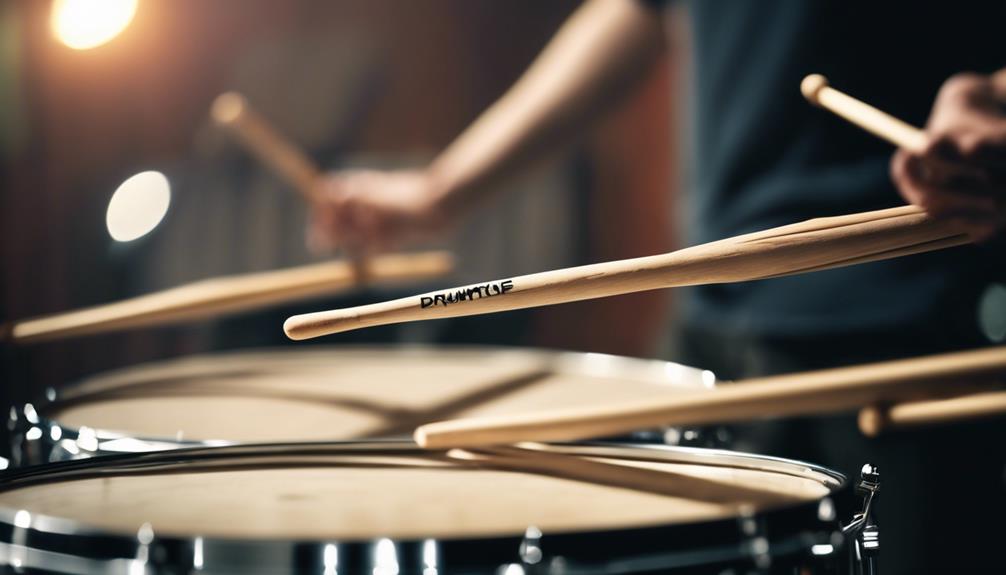
Now that you’ve explored the dynamic flair of the flamacue, let’s tackle the Triple Stroke Roll to further enhance your drumming technique. This rudiment involves playing three strokes consecutively with each hand, a pattern that challenges your control, coordination, and hand speed.
When you first start practicing the Triple Stroke Roll, it’s important to take it slow. Focus on playing each stroke cleanly and evenly. Begin at a comfortable tempo where you can maintain control, then gradually increase your speed as you gain proficiency. This methodical approach guarantees that you build a solid foundation before pushing your limits.
The Triple Stroke Roll is more than just a technical exercise; it’s an essential part of your drumming vocabulary. By mastering it, you’ll free yourself to play more complex rhythms and intricate patterns. The control and speed you develop will translate into smoother, more precise drumming in various musical contexts.
Incorporate the Triple Stroke Roll into your practice routine regularly. You’ll notice improvements in your ability to play fast passages with clarity and precision. Remember, the key to mastering this rudiment is consistent, focused practice. Keep pushing your boundaries, and you’ll see significant progress.
Single Ratamacue
Explore the Single Ratamacue, a rudiment that sharpens your hand speed, control, and coordination. This drum rudiment consists of a single grace note followed by a series of alternating single and double strokes. It’s challenging but incredibly rewarding, pushing you to improve your precision and dexterity.
The Single Ratamacue isn’t just a technical exercise; it’s a powerful tool commonly used in drum solos, fills, and fast-paced sections of music. By incorporating it into your practice routine, you’ll notice significant improvements in your overall drumming proficiency and creativity.
Here’s why you should focus on mastering the Single Ratamacue:
- Hand Speed: It boosts your ability to execute fast, clean strokes.
- Control: It requires precise timing and coordination between your hands.
- Dexterity: It enhances your finger and wrist movements, making your playing more fluid.
- Versatility: It’s useful in various musical contexts, from solos to fills.
- Creativity: It opens up new rhythmic ideas and patterns for you to explore.
Don’t underestimate the impact of this rudiment. Practicing the Single Ratamacue diligently will transform your drumming technique, making you a more skilled and adaptable drummer.
Practice Tips

To make the most of your drum practice, use a metronome to guarantee your tempo stays steady.
Practice consistently every day, focusing on short, concentrated sessions.
This approach will help you build muscle memory and improve your coordination over time.
Metronome for Steady Tempo
A metronome will be your best friend for developing a consistent sense of rhythm and timing when practicing drum rudiments. This device produces steady beats to help you maintain tempo during practice sessions, guaranteeing your playing remains precise and accurate. By incorporating a metronome into your routine, you’ll greatly enhance your overall musical performance.
Here are some key benefits of using a metronome:
- Vital: It helps you stay on beat, making your drumming more reliable.
- Speed Control: You can adjust the tempo to gradually increase your speed and challenge yourself.
- Precision: Practicing with a metronome enhances your accuracy and timing.
- Rhythmic Awareness: It builds a stronger sense of rhythm, essential for any drummer.
- Musicality: Your overall musical interpretation and expression improve as you play in time.
During your practice sessions, set the metronome to a comfortable tempo and focus on maintaining that beat. Start slow to guarantee accuracy, then gradually increase the tempo as you become more confident.
This methodical approach not only hones your technical skills but also ingrains a natural sense of timing, making your drumming more fluid and expressive. Incorporate the metronome into your daily practice, and you’ll see noticeable enhancements in your drumming technique.
Consistent Daily Practice
Consistent daily practice is essential for mastering drum rudiments and developing your drumming skills rapidly. As a beginner, dedicating just 10-15 minutes each day to practice can yield noticeable improvements within a week. Drumeo Beat40 Drum Rudiments is an excellent resource to guide your practice sessions.
To build muscle memory and enhance coordination, stick to a routine. Start with simple rudiments and gradually increase their complexity. Using a metronome guarantees precision in your timing and rhythm, which is vital for any drummer. It helps you stay consistent and develop a steady tempo, making your practice more effective.
Focus on maintaining consistent stick height and hand placement. This consistency will make your rudiments more precise and controlled.
Break down complex rudiments into smaller parts. Master each part separately before combining them. This approach makes it easier to grasp challenging patterns and ensures a smoother learning process.
Next up, learn how to read drum notation in this guide.
